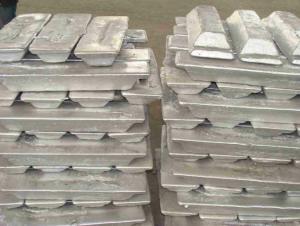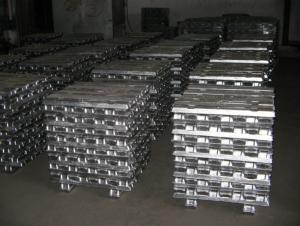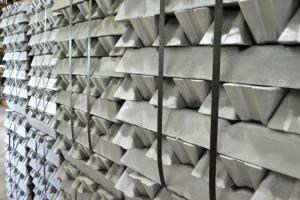Aluminum Ingots AA1060
- Loading Port:
- Shanghai
- Payment Terms:
- TT or LC
- Min Order Qty:
- 20 Tons m.t.
- Supply Capability:
- 1000 Sets Per Month m.t./month
OKorder Service Pledge
Quality Product, Order Online Tracking, Timely Delivery
OKorder Financial Service
Credit Rating, Credit Services, Credit Purchasing
You Might Also Like
1. Specifications of Aluminum Ingots AA1060
| Product Name | Aluminum Ingot |
| Chemical Composition | Al |
| Weight | 20/25kg |
| Al (Min) | 99%-99.9% |
| Appearance | silvery white |
| Advantages | easy control and operation, fast melting |

2. Usage/Application of Aluminum Ingots AA1060
A. mainly used for melting ingot
B. discontinuous melting with scrap
3.Packaging & Delivery of Aluminum Ingots AA1060
About 25Kg /Ingot, Packed in wooden case, Net weight 1000Kg/ Case, or as customer's requirements.
- Q: Can aluminum ingots corrode?
- Yes, aluminum ingots can corrode.
- Q: How to make aluminium box into aluminium ingot?
- The problem of aluminum is not high, it can be dissolved directly with a dry pan, but it should not be dissolved directly. Because the aluminum ingot is pure aluminum, and the aluminum box should have impurities. The smoke isn't too big.
- Q: How are aluminum ingots stored and transported?
- Aluminum ingots are typically stored and transported in a careful and systematic manner to ensure their safety and quality. Firstly, ingots are usually stored in warehouses or storage facilities specifically designed for handling metals. These facilities are equipped with adequate ventilation, temperature control, and protection against moisture to prevent any damage or contamination. To store aluminum ingots, they are typically stacked on pallets or placed in racks, depending on the size and weight of the ingots. The ingots are arranged in a way that allows for easy access and ensures stability during storage. In some cases, ingots may be individually wrapped or covered with protective materials to prevent scratching or surface damage. When it comes to transportation, aluminum ingots are usually moved using various methods depending on the distance and quantity. For shorter distances, smaller quantities of ingots can be transported using forklifts or hand trucks. In these cases, it is important to secure the ingots properly to prevent any movement or potential falling during transport. For longer distances, larger quantities of aluminum ingots are typically transported by trucks, trains, or ships. These transportation methods often require specialized containers or trailers designed to hold the ingots securely and protect them from external factors. In some cases, ingots may be loaded into shipping containers or placed on flatbed trailers. It is crucial to ensure proper handling and securing of aluminum ingots during transportation to minimize the risk of damage or accidents. The transportation containers or vehicles should have appropriate padding or cushioning to absorb any potential shocks or vibrations that could potentially impact the ingots. Overall, the storage and transportation of aluminum ingots involve careful planning, adherence to safety protocols, and the use of specialized equipment to maintain their quality and integrity throughout the process.
- Q: Want to do a scrap processing of aluminum ingots of small workshops, about investment of about 100 thousand, the specific process, need what equipment technology, please expert advice
- This is the necessary experience, many small factory workshops, factories are invited to experience the master operation, provide very high reward,
- Q: How does the ADC12 die casting aluminium ingot contain copper?
- If the Cu exceeds the standard, and the quantity of the aluminum ingot is large enough, you can make a batch of low copper alloy mixture. But the above are more complicated. Since the aluminum ingot is not qualified, it is better to be replaced by the aluminum ingot maker
- Q: What are the main factors influencing the choice between aluminum ingots and aluminum slabs?
- The main factors influencing the choice between aluminum ingots and aluminum slabs include the specific application requirements, production processes, cost considerations, and transportation logistics.
- Q: How is aluminium ingot produced?
- 1, electrolytic aluminum production process: bauxite - alumina - electrolytic aluminum.2, in accordance with the main component content of aluminum ingot can be divided into three categories: advanced pure aluminum (aluminum content of 99.93-99.999), industrial high-purity aluminum (aluminum content of 99.85-99.90), industrial pure aluminum (aluminum content of 98.0-99.7).
- Q: How is the purity of an aluminum ingot determined?
- The purity of an aluminum ingot is typically assessed using various analytical techniques, with one of the most common methods being the utilization of a spectrometer to measure the elemental composition. This method, known as optical emission spectroscopy (OES) or spark testing, involves vaporizing a small sample of the ingot using an electric spark and analyzing the resulting emission of light. Each element emits a distinct spectrum of light, and by comparing the intensities of these spectral lines to known standards, the concentration of different elements in the ingot can be determined. This allows for the identification and quantification of impurities such as iron, copper, silicon, and other trace elements. Another approach to evaluating purity is through chemical analysis, which entails dissolving a sample of the ingot in an appropriate acid or solvent and conducting various chemical reactions to quantify the impurities. For instance, atomic absorption spectroscopy (AAS), a common technique, can be utilized to measure the concentration of specific elements in the solution. In addition to these analytical techniques, non-destructive tests like ultrasound or X-ray analysis can also be employed to assess the integrity and purity of the aluminum ingot. These methods are capable of detecting any internal flaws or inclusions that could potentially impact the quality of the ingot. In conclusion, a combination of these analytical techniques is employed to determine the purity of an aluminum ingot, ensuring that it meets the necessary specifications for diverse industrial applications.
- Q: What is the difference between a aluminium ingot with and without a ticket?
- The general you do not vote, which they will put the invoice that give you the money saved, but why don't you take this ticket, if you can not keep the newspaper, after a document, you want to good, advise you best to say that, on the use of the receipt, not the authority
- Q: What does nonstandard pure aluminium ingot mean?
- For direct casting, the casting is good in toughness but not in strength and poor in physical properties.
We are a well-known enterprise specializing in the production and sales of aluminum sheets and coils.
Since the establishment of us, we have been devoted to setting up a good CIS and completely implementing ISO9001 quality management system.
1. Manufacturer Overview
| Location | Henan,China |
| Year Established | 1993 |
| Annual Output Value | Above US$200 Million |
| Main Markets | Mid East;Eastern Europe;North America |
| Company Certifications | ISO 9001:2000;ISO 14001:2004;OHSAS 18001 |
2. Manufacturer Certificates
| a) Certification Name | |
| Range | |
| Reference | |
| Validity Period |
3. Manufacturer Capability
| a) Trade Capacity | |
| Nearest Port | Shanghai |
| Export Percentage | 30%-50% |
| No.of Employees in Trade Department | 21-50 People |
| Language Spoken: | English;Chinese |
| b) Factory Information | |
| Factory Size: | Above 100,000 square meters |
| No. of Production Lines | Above 10 |
| Contract Manufacturing | OEM Service Offered;Design Service Offered |
| Product Price Range | Average |
Send your message to us
Aluminum Ingots AA1060
- Loading Port:
- Shanghai
- Payment Terms:
- TT or LC
- Min Order Qty:
- 20 Tons m.t.
- Supply Capability:
- 1000 Sets Per Month m.t./month
OKorder Service Pledge
Quality Product, Order Online Tracking, Timely Delivery
OKorder Financial Service
Credit Rating, Credit Services, Credit Purchasing
Similar products
Hot products
Hot Searches
Related keywords


























